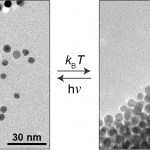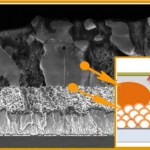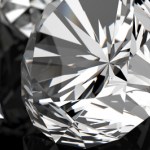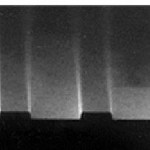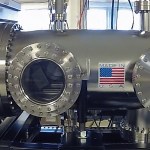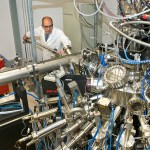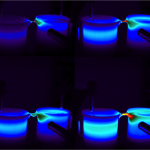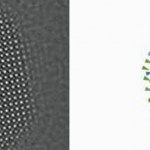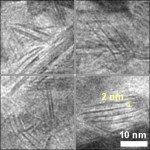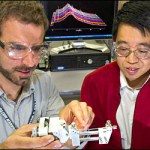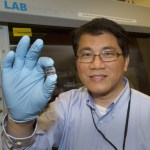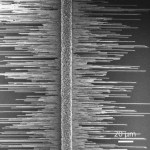Materials Science
One day in the future, we may be treating our ailments with microbiotic combinations designed specifically to correct imbalances in our personal microbiomes. We’ll bring our prescriptions on rewritable paper and pay using shimmery optical chips embedded in our cell phone cases or maybe our jewelry. Or we’ll be waiting in our doctor’s office for a simple test of our microbiogenome to see if a light-based nanoparticle delivery treatment is working, while watching iridescent optical displays that change as we move...
These future scenarios (and many more) are all imaginary, but…
Perovskite (say it: pə-ˈräv-ˌskīt, -ˈräf-). It may never become a household word, and the chemical formulas (eg., CH3NH3PbI3−xClx ) are as long as the name. But if you find yourself, in the not-so-distant future, adding new-and-improved solar panels to your roof, they may well contain a perovskite layer. If they do, it will be these “wonder materials” that will make your panels cheap enough to make your investment worthwhile and efficient enough to make you feel smug when you get your electricity bill.
You may ask: Aren’t solar panels dropping in price all the time? What is special…
Since the haiku post was well received, and since we have another three pieces online today – each on a different finding and each interesting in its own right – I have decided to return to the haiku format. Among other things, there is something quite satisfying about distilling complex scientific findings down to 17 little syllables – like writing the perfect tweet, but more so.
In any case, follow the links to read more:
A burst of enzymes:
A transcription traffic jam
Watch for gene speed bumps
Genetics can rid
The poison from potatoes
Or add it elsewhere
image: Thinkstock…
Brookhaven Lab physicist John Smedley wrote this post.
People use diamonds to cut concrete, sharpen knives, and jumpstart wedding plans. As a member of Brookhaven’s Instrumentation Division, I’m on a team that found that diamond also fits the bill for new components in cutting-edge tools we are designing for upgrades for the Relativistic Heavy Ion Collider (RHIC), future linear-accelerator light sources, the National Synchrotron Light Source (NSLS), and NSLS-II-- facilities that researchers from around the world are using to understand more about how the natural world works and how we can…
Is anyone old enough to remember the ad in which two people walking down the street while snacking accidently bump into each other and discover peanut butter on a chocolate bar? Well, it turns out that when physics students run into each other on the street, the result is a quasicrystal with topological properties.
The students in question were members of two different labs in two different physics departments who were both out for a stroll on the same street in Tel Aviv – far from Rehovot and the Weizmann Institute. One was experimenting with a new kind of quasicrystalline optical system –…
Ever imagined that an Xbox controller could help open a window into the nanoworld of groundbreaking physics? Well, check out the video above.
Brookhaven scientist Ray Conley designed that one-of-a-kind machine to grow (through a technique called sputtering deposition) atomically precise lenses that can focus x-rays to within one billionth of one meter, revealing the internal nanoscale structure of materials such as electric vehicle fuel cells.
When tweaking his recipe for these multilayer Laue lenses (MLL), Conley used to have to manually enter commands into a computer to move a crucial…
See the way those smooth, amorphous blobs rapidly transform into textured honeycombs? Something similar is probably happening right now inside your laptop or smartphone’s battery, providing you with portable power.
But the cherished efficiency and portability of those compact lithium-ion batteries comes with a cost: each cycle of discharge/recharge degrades the material’s essential structure and ultimate longevity - you’ve probably noticed that your older electronics just don’t hold a charge like they used to. Preventing this persistent degradation requires insight into a process that plays…
High-temperature superconductors (HTS), capable of storing and transmitting electricity with perfect efficiency, are a theoretical stumbling block. The mechanism underlying HTS behavior is a mystery, and the subject of significant contention and investigation among scientists. This puzzle, unlike headline-making unknowns such as dark energy (admittedly awesome and worth losing sleep over), could revolutionize our entire energy infrastructure. But before HTS materials can flood the electricity market, they need to work their magic closer to room temperature (high-temperature is a bit…
The term “floating water bridge” may sound nonsensical, but it’s the most logical name for a phenomenon that occurs when two beakers of water set slightly apart are zapped with high-voltage electricity and the water molecules jump across the gap to connect and form a thin thread of water. The molecular structure that suspends this liquid bridge has stumped scientists for over a century.
Now, a team of scientists has peered into floating water bridges with high-energy x-rays using the Advanced Photon Source (APS) at Argonne National Laboratory. Their work, “Floating water bridges and…
One of physics’ greatest tricks is polarization. Take magnets, for example, such as those commonly found on refrigerators holding up shopping lists and Christmas cards. These have the familiar north/south polarization that we can experience as attraction and repulsion. That magnetic orientation persists all the way down to the individual molecules, which actually align to cause the larger-scale behavior.
This polar phenomenon is caused by ferromagnetism, a defining quality of some particles that gives them an intrinsic polarity – what scientists call a dipole moment. And remarkably, that…
With nanotechnology rapidly advancing, the sci-fi dream of a Star Trek replicator becomes increasingly less fantastic. But such radical technology would, in theory, require the kind of subatomic manipulation that far exceeds current capabilities. Scientists lack both the equipment and the fundamental knowledge of quantum mechanics (the Standard Model, for all its elegance, remains incomplete) to build items from the raw stuff of quarks, gluons, and electrons . . . but what about alchemy?
Even Isaac Newton, credited with the dawn of the Age of Reason, felt the mystical draw of alchemy,…
Building 3D images gets trickier with objects bilions of times smaller. (courtesy Electric-Eye on Flickr)
Let's start with a number, by chance a palindrome: 1441. Imagine taking that many photographs of a single object, a soccer ball, say - obsessively capturing it from every angle to expose all the details. Those 1441 images provide all the evidence needed to illustrate and understand the three dimensional structure of that soccer ball. Each shot reveals another curve of the sphere, another line in the checkered pattern, another scuff or scratch along the surface.
An adept programmer or…
This guest post was written by Mona S. Rowe, science writer for Brookhaven National Laboratory's National Synchrotron Light Source (NSLS) and NSLS-II.
The quest to authenticate an unknown Rembrandt painting, titled "Old Man with a Beard," hit a dramatic high at the National Synchrotron Light Source (NSLS) at Brookhaven National Laboratory. Using an advanced x-ray detector developed at NSLS, scientists found compelling evidence that the famous Dutch master did indeed have his own hand on the painting.
"After doing the experiments at NSLS, I felt that the painting I held in my hands was a…
Jason Graetz, left, and Jiajun Chen at NSLS beamline X14A with their transparent reactor for viewing chemistry in real time.
Here's a recipe for basic chemistry: Mix a bunch of stuff in a reaction vessel and see what happens. Only you don't really see the action taking place -- unless you have some way to visualize the molecular magic.
Researchers at Brookhaven National Laboratory have developed just such a technique: They've fabricated a transparent chemical reactor vessel that allows x-rays to pass through and capture the chemical changes as they take place.
They recently used this…
The following guest post was written by Wei-Qiang Han, a materials scientist working at Brookhaven Lab's Center for Functional Nanomaterials.
Wei-Qiang Han
With gasoline prices still hovering near $4 per gallon, scientists at Brookhaven Lab's Center for Functional Nanomaterials (CFN) are helping to develop electric vehicles capable of driving hundreds of miles on a single charge. A new compound of five tin atoms and one iron atom (FeSn5) created at the CFN is another development along the road to higher capacity lithium-ion batteries for those vehicles of the future.
Compared to other…
A recent study by Prof. Ernesto Joselevich and his team, published in Science, features perfectly aligned horizontal arrays of thin, millimeter-long nanowires. We spoke with Joselevich recently to find out why he and others in the field are excited by this advance:
WSW: Your lab has produced a fair amount of innovative research in recent years. Why is this one special?
EJ: First of all, we succeeded in growing very long horizontal nanowires with exquisite control over their orientation. Because of the numerous potential uses for semiconductor nanowires, there is a lot of competition to…
Metals have often been overlooked as a viable field for innovation, but materials scientist Ainissa Ramirez is helping to change that. Her groundbreaking research has resulted in new ways to control and shape metals into materials that can be put to practical everyday use - from producing stronger circuitry for cell phones to developing more efficient medical devices that save lives. "The diverse applications of these metals have made them increasingly important and visible to the world," says Ainissa, associate professor of Mechanical Engineering at Yale University where research on shape…
This one-liner from the 1967 classic "The Graduate" might have made Benjamin Braddock (Dustin Hoffman) cringe:
But 43 years later, it's obvious that Mr. McQuire was onto something. Today, it's hard to imagine life without plastic, from brushing your teeth in the morning to pouring yourself a glass of milk. We produce so much of the stuff, though, that we now face major environmental problems. Conventional plastic is made from crude oil, is not often recycled, and, when put in landfills, can release toxins that enter soil, water, and the food chain.
Researchers at Brookhaven and Dow…
Merged series of phase contrast micrographs showing neurite outgrowth in rat dorsal root ganglion cells grown on an acetylcholine biopolymer. (Christiane Gumera)
Last year, Yadong Wang and his colleagues at the Georgia Institute of Technology reported that they had produced a dopamine biopolymer that promotes the growth of neurites in PC12 cells.
Now, the team have taken that work one step further, with the finding that another similar polymer has the same effect on nerve cells. When Wang and Ph.D. student Christiane Gumera cultured the cells on an acetylcholine…
A mussel clinging to a sheet of teflon. (Image credit: Haeshin Lee/ Phillip Messersmith)
The marine mollusc Mytilus edulis inhabits ecological niches in the intertidal zone, which is exposed to air during low tide and submerged in water during high tide. Being so turbulent, these niches are inhospitable to many forms of life; the organisms that do inhabit such harsh conditions are suitably adapted, and the success of the mussel is due largely to its ability to adhere to virtually any kind of surface.
The mussel's steadfast grip is achieved by means of collagenous threads consisting of…
